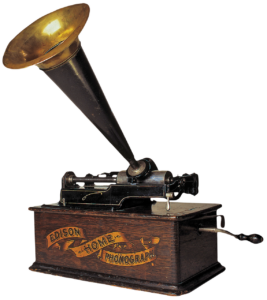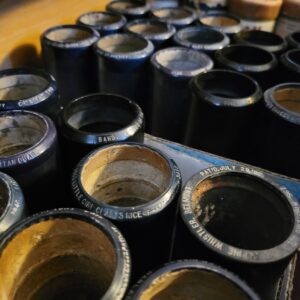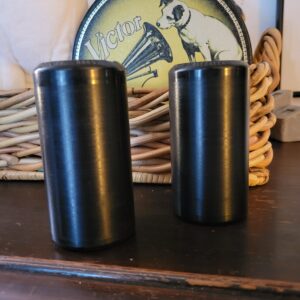Table of Contents
In an era where streaming services and digital downloads dominate our music consumption, it’s easy to overlook the rich history that has paved the way for today’s instant gratification audio experience. One of the fascinating relics of sound recording history is the phonograph cylinder, a seemingly primitive yet groundbreaking technology of its time. This cylindrical device went through several iterations, from tin foil to wax, to bring music, voices, and other sounds into households around the world. Let’s explore this incredible journey and understand how the evolution of phonograph cylinders shaped the audio world as we know it.

The First Phonograph: Tin Foil Cylinders
Thomas Edison is often credited with the invention of the phonograph in 1877. Although the idea of sound recording was not entirely new, Edison’s device was the first to both record and play back sound. Initially, he used a cylinder wrapped in tin foil as the recording medium. A stylus etched the sound vibrations into the foil as the cylinder rotated, allowing it to be played back later.
The invention of the phonograph using tin foil cylinders was a monumental moment in history, capturing the imaginations of people worldwide. Public demonstrations were held where crowds gathered to witness this technological marvel, sometimes even leading to disbelief and accusations of trickery. It was a piece of “magic” that allowed people to hear recorded sound for the very first time, providing not just entertainment but also opening the door for future applications in communication and archival purposes.
Despite the marvel it was, tin foil cylinders had their limitations. They were fragile, could only be played a few times before degrading, and the sound quality was far from ideal. The nature of the tin foil medium meant that the grooves created by the stylus would start to flatten almost immediately upon playback, thus shortening the lifespan of the recording drastically. Each recording was unique, meaning it couldn’t be mass-produced, limiting its applications largely to novelty and dictation.
Nevertheless, the invention of the tin foil phonograph provided a proof of concept that spurred further innovation. Engineers and inventors were drawn to the challenge of improving upon Edison’s initial design. Businesses saw the potential for commercial applications, ranging from home entertainment to office dictation services. While limited, the tin foil cylinder served as a stepping stone, catalyzing interest and research in the field of sound recording.
The Wax Revolution
Enter Alexander Graham Bell. Intrigued by Edison’s invention, Bell and his collaborators, including his cousin Chichester Bell and Charles Sumner Tainter, made significant strides to improve upon the existing technology. By the 1880s, they had developed a more durable wax cylinder, sometimes called the Graphophone. The sound was etched into a wax surface, which provided greater fidelity and longevity compared to its tin foil predecessor.

The transition from tin foil to wax was not just a material change; it marked a sea change in the possibilities of sound recording. With wax cylinders, the clarity of sound improved dramatically, offering a more nuanced auditory experience. String instruments could be heard more distinctly, the resonance of vocals became richer, and overall, the acoustic elements were captured more faithfully.
Wax cylinders also allowed for more intricate editing and mastering processes. Unlike tin foil cylinders, which were largely ‘one-take wonders,’ wax cylinders could undergo certain treatments to enhance their sound quality. Techniques like “dubbing” were developed, albeit in a very rudimentary form compared to today’s standards, which allowed for the layering of sounds and multiple takes.
Another significant development was the advent of “molded” cylinders in the late 1890s and early 1900s. These were created using a molding process that allowed for mass reproduction from a single master cylinder. This was groundbreaking because, for the first time, artists and record companies could produce copies of their recordings on a large scale, making it possible to distribute them widely and sell them commercially.
As a result, the business of sound recording took a massive leap forward. The Edison Phonograph Company and Columbia Records, among others, began mass-producing wax cylinders and building catalogues of various types of music, from classical to folk to the burgeoning genre of jazz. It was also during this time that the concept of a “recording artist” came into being—musicians who gained fame and livelihood not just from live performances but also from their recorded works.
Over time, various types of wax, like beeswax and ceresin, were experimented with to improve sound quality and durability further. Efforts were made to create colored wax cylinders, with different colors indicating different genres or perhaps the quality of the recording. However, these never gained widespread adoption.
Commercial Success and Cultural Impact
With the mass production of wax cylinders, for the first time, people could enjoy musical performances without attending a live concert. This had a massive impact on society and how we consumed music and other forms of auditory entertainment. Companies specializing in the production and distribution of these cylinders started to emerge, turning recorded sound into a commercial enterprise.
The arrival of wax cylinders coincided with the rise of urban centers and a burgeoning middle class. As people moved to cities for work, entertainment options diversified. Wax cylinders became a popular form of home entertainment, giving urbanites the chance to unwind to music or spoken performances in the comfort of their living rooms. The cylinder phonograph was no longer just an intriguing novelty; it became a staple in households, akin to what television sets and streaming devices are today.
One cannot underestimate the impact on musicians and performers, either. Before wax cylinders, fame was often limited to how far an artist could travel and how many people they could perform for in person. However, with the mass production and distribution of cylinders, artists had the opportunity to reach a much larger audience. Some performers became early recording stars, their talents immortalized in wax, effectively creating the concept of the “recording artist” as distinct from a live performer.
Beyond music, wax cylinders were also used to record important speeches, historical events, and even audio letters that could be sent by mail. Families could send recordings to each other over distances, capturing the voices and sentiments of loved ones in a way that written letters couldn’t. Not only did this technology revolutionize entertainment, but it also impacted social interactions and the way we remember historical events.
Additionally, the commercial success of wax cylinders influenced the educational sphere. Some of the earliest uses included language learning and spoken-word performances of literary works, making education more accessible and interactive. Schools and universities started integrating phonograph technology into their curricula, providing students with a multimedia learning experience long before the age of the internet.
The impact on culture was profound. The ability to record, distribute, and consume sound had ripple effects across various sectors, including journalism, politics, and the arts. Newspapers started reviewing recordings as they would live performances, candidates used them for political campaigns, and artists experimented with this new medium to create unique auditory experiences. Moreover, the philanthropic aspect of this technology was soon recognized. Recorded music, speeches, and plays started to be used in hospitals, sanatoriums, and other public institutions as a form of therapy and public outreach, marking one of the earliest instances of music therapy.

Decline and Legacy
As revolutionary as the wax cylinder was, it wasn’t destined to remain the dominant format for sound recording. By the early 20th century, technological advances led to the development of flat disc records, which were easier to mass-produce, store, and ship. These disc records had the added advantage of longer playback times, and as gramophones became more popular, the market for wax cylinders began to wane.
Despite losing market dominance, wax cylinders didn’t disappear entirely. For a time, they found niche applications, especially in the realm of dictation and specific professional uses. However, as magnetic tape and later digital formats emerged, wax cylinders became increasingly obsolete, ultimately relegated to the status of historical artifacts and collector’s items.
Yet, their legacy is far from forgotten. Museums and historical societies hold wax cylinder recordings as valuable cultural assets, as they capture the voices and sounds of a bygone era. Efforts are underway to digitize these recordings to preserve them for future generations. They serve as audible time capsules, offering unique insights into the musical, linguistic, and social norms of their respective periods.
It’s important to note that the decline of wax cylinders led to a focus on refining and improving newer technologies, a testament to the power of iterative innovation. The limitations of wax cylinders encouraged inventors and engineers to develop alternative recording media, setting the stage for the records, tapes, CDs, and digital formats that followed. Each step, from wax cylinders to today’s streaming services, can be seen as part of a continuum, a series of answers to the enduring question: how can we best capture and reproduce sound?
Moreover, the wax cylinder era had a lasting impact on copyright laws and intellectual property. As one of the first formats that allowed for the mass distribution of recorded sound, it prompted legal and ethical questions about ownership, royalties, and the rights of performers and composers. This led to the establishment of legal frameworks that continue to shape the music and entertainment industries today.
In the broader cultural context, wax cylinders played a critical role in democratizing access to art and culture. They introduced the concept of “home entertainment” and paved the way for the music industry as we know it today. Although they may be obsolete as a technology, their impact reverberates through our modern understanding of music, culture, and mass media.
So, while the era of the wax cylinder may be long past, its influence is far from over. It stands as a milestone in the history of audio technology, a symbol of human ingenuity and the ever-evolving quest to capture the ephemeral magic of sound. Its decline is not so much an end, but rather a transformative point in a long line of innovations that have shaped how we interact with, and value, the world of sound.
